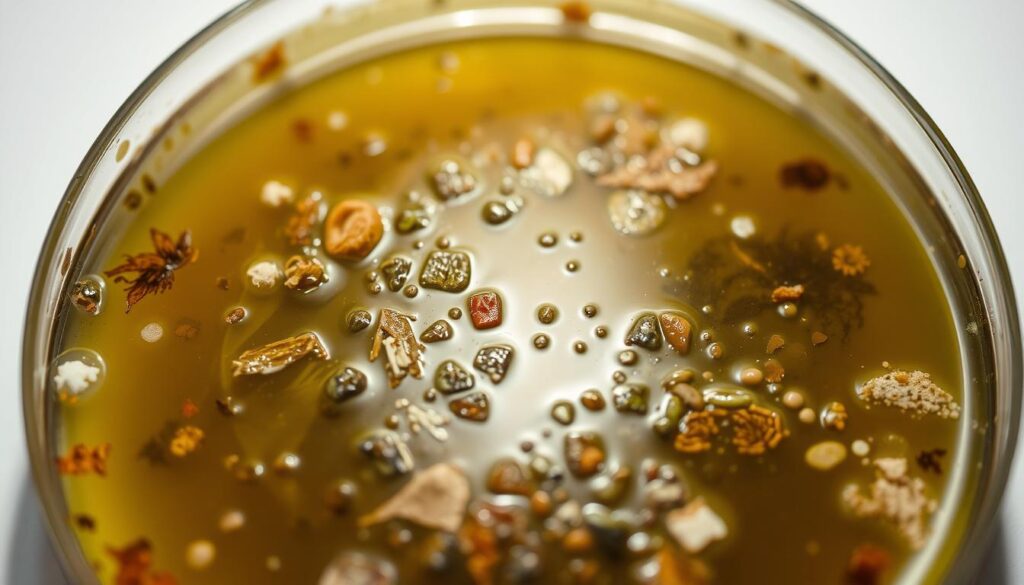Have you ever paused before filling your glass from the faucet, wondering what might be lingering in your tap water? Many Americans share this quiet concern as new contaminants emerge in aging infrastructure. Among these, Dichloroacetic acid (DCA) has drawn particular attention from health researchers and homeowners alike.
Modern purification methods have become essential for safeguarding households. Reverse osmosis stands out for its ability to remove up to 99% of impurities, including stubborn chemical compounds. Third-party tested systems like CovePure’s RO units meet rigorous NSF/ANSI standards 42, 53, and 58 – a benchmark we’ll explore in detail.
This article grew from our team’s own journey through water quality research. We’ll break down how DCA enters drinking supplies, why prolonged exposure matters, and what makes advanced filtration effective. You’ll also learn key features that differentiate reliable systems from basic pitchers.
Our goal? To help you make informed decisions about protecting your family’s health through smarter hydration choices. Let’s examine the science behind clean water solutions – and why they’ve never been more crucial.
Understanding Dichloroacetic Acid (DCA) in Our Water Supply
Many households face an invisible challenge when turning on their faucets. Chemical byproducts from municipal water treatment processes often linger in drinking supplies, creating complex safety questions. Let’s explore how these substances form and enter our homes.
Investigating the Origins of DCA Contamination
DCA belongs to a group called haloacetic acids (HAAs), formed when chlorine reacts with organic matter during disinfection. While essential for eliminating pathogens, this chemical reaction unintentionally creates secondary contaminants.

Agricultural runoff and industrial waste introduce additional organic compounds to reservoirs. These substances act as building blocks for HAAs when mixed with disinfectants. Treatment plants face a delicate balance – destroying harmful microbes while minimizing byproduct creation.
Pathways for DCA Entry into the Water System
Three primary routes allow these compounds into homes:
- Aging distribution pipes leaching materials
- Variable chlorine levels during seasonal demand spikes
- Incomplete removal by basic carbon filters
Standard pitcher systems often lack the precision to address smaller molecules like HAAs. Advanced membrane technologies prove more effective at molecular separation, as we’ll explore in later sections.
Recognizing these contamination sources helps homeowners evaluate protection strategies. Knowledge of water quality challenges informs smarter decisions about household purification needs.
Chronic Exposure to DCA: Health Concerns and Academic Insights
The ripple effects of long-term chemical exposure often reveal themselves slowly – a reality underscored by recent environmental studies. Researchers have identified health risks associated with haloacetic acids that accumulate in drinking supplies over years. Let’s examine what peer-reviewed findings mean for households.
Reviewing Environmental and Health Research
Multiple universities have tracked contamination levels in municipal systems since 2018. Their work shows that even trace amounts of certain compounds – when consumed daily – may alter cellular functions. One Journal of Environmental Health study linked prolonged exposure to liver complications and metabolic disruptions.

Long-Term Exposure Implications
Three critical insights emerge from the data:
- Continuous intake correlates with increased cancer risks
- Children’s developing systems show heightened sensitivity
- Standard treatment methods reduce but don’t eliminate contaminants
Monitoring your supply’s quality becomes vital, as EPA guidelines only address short-term exposure limits. Many homeowners now test annually rather than relying solely on municipal reports.
While no system guarantees complete safety, advanced purification significantly lowers these risks. We’ll explore practical solutions in the next section – because informed choices start with understanding the stakes.
Exploring the Benefits of Reverse Osmosis Over Standard Pitcher Filters
When choosing home purification methods, many gravitate toward convenience. Yet effectiveness against modern contaminants requires deeper analysis. Let’s examine why advanced systems outperform basic solutions.
How Reverse Osmosis Outperforms Traditional Pitcher Filters
Standard pitchers rely on activated carbon to trap larger particles. This process improves taste and reduces visible impurities but struggles with smaller molecules. Chemical byproducts like dichloroacetic acid slip through due to their microscopic size and neutral charge.
Membrane-based systems employ a multi-stage approach. Semi-permeable barriers block contaminants at the molecular level, including those from chlorine reactions. Independent studies show these units remove 94-98% of haloacetic acids compared to 20-40% with basic filters.
Three critical differences emerge:
- RO addresses 100+ contaminants versus 5-10 in pitchers
- Membrane pores measure 0.0001 microns – 100,000x smaller than carbon filters
- Automatic flushing prevents chemical buildup in filtered water
While pitcher systems may improve tap water clarity, they leave health-critical compounds untouched. Prolonged consumption of untreated byproducts has been linked to cellular changes in peer-reviewed research. Advanced purification offers stronger safeguards for household supplies.
Municipal reports confirm seasonal spikes in chlorine levels accelerate acid formation. Only technologies with molecular separation capabilities provide consistent protection against these fluctuations. For families prioritizing long-term wellness, the choice becomes clear.
The Advantages of the Best Water Filter Dichloroacetic acid DCA: Spotlight on CovePure
As contaminants evolve, so must our approach to eliminating them. CovePure’s reverse osmosis system emerges as a leader in addressing modern purification challenges through rigorous engineering and third-party validation.
Precision Removal Technology
Independent SGS testing confirms CovePure’s membrane achieves 99.9% reduction rates for over 100 substances. Its multi-stage process tackles microscopic threats most systems miss, including:
- Chlorine reaction byproducts
- Metallic residues from aging pipes
- Organic compounds below 0.001 microns
The system’s materials exceed NSF/ANSI standards 42, 53, and 58 for material safety and structural integrity. This ensures no chemical leaching during disinfection cycles.
Broad-Spectrum Protection
Beyond targeting specific acids, CovePure addresses multiple contaminant categories simultaneously. Users benefit from reduced levels of:
- Pharmaceutical traces
- Agricultural runoff chemicals
- Industrial solvents
Regular water quality tests show consistent performance across varying supply conditions. For households prioritizing long-term safety, this comprehensive approach minimizes exposure risks better than single-issue solutions.
Key Features to Look for in an Effective Reverse Osmosis System
Choosing the right purification technology requires understanding what separates adequate systems from exceptional ones. We’ve identified critical benchmarks that ensure both immediate results and lasting safety.
Certifications, SGS Testing, and Industry Standards
Third-party validation separates marketing claims from measurable performance. Look for NSF/ANSI certifications 42 (aesthetic effects), 53 (health contaminants), and 58 (reverse osmosis systems). These standards verify:
- Material safety preventing chemical leaching
- Structural durability under pressure fluctuations
- Consistent process efficiency over time
SGS testing adds another layer of scrutiny, confirming removal rates for specific compounds. CovePure’s CP-16 model, for instance, underwent 1,200-hour stress tests to validate its 99.9% contaminant reduction claims.
Performance Metrics and Contaminant Coverage
Effective systems address multiple risk factors simultaneously. Compare these metrics when evaluating options:
- Minimum 95% removal rate for 100+ substances
- Automatic shutoff valves preserving membrane life
- 1:1 wastewater ratio or better
Comprehensive coverage matters because municipal supply quality fluctuates seasonally. Units with broad-spectrum protection guard against emerging issues like pharmaceutical residues or pesticide runoff.
Prioritizing these features reduces long-term health risks linked to organ stress and metabolic issues. By selecting rigorously tested systems, homeowners gain confidence in every glass poured.
Enjoy a Limited-Time $200 Discount on CovePure CP-16 for Superior Safety
Protecting your household shouldn’t require complex steps or hidden costs. For a limited period, homeowners can secure advanced purification technology at a reduced price – making premium safeguards accessible.
Simplified Savings for Modern Homes
We’re excited to share an exclusive $200 reduction on CovePure’s CP-16 system. This promotion requires no coupon codes or special requests – simply visit their official site during the offer window. Families prioritizing long-term safety can now address concentration concerns without stretching budgets.
Three reasons this matters:
- Carbon block technology becomes affordable for first-time buyers
- Multi-year protection against emerging contaminants
- Direct savings equivalent to 6 months of bottled water costs
Seasonal shifts often increase chemical concentration in municipal supplies. This discount helps households proactively address fluctuating quality issues before they escalate. With proper maintenance, the system delivers reliable performance for 5+ years – a smart investment in daily wellness.
Time-sensitive offers like this rarely align with evolving family needs. If you’ve considered upgrading from basic carbon-based solutions, don’t miss this opportunity. Visit CovePure’s website today to claim your discount and transform how you safeguard loved ones.
Ensuring Safe Drinking Water Through Advanced Filtration Practices
Modern homes deserve more than temporary fixes for persistent contamination issues. Our analysis reveals that chemical byproducts demand sophisticated removal methods – basic solutions simply can’t address evolving risks effectively.
Third-party validated systems like CovePure’s RO units demonstrate how multi-stage filtration tackles a variety of threats simultaneously. These technologies reduce 99% of impurities through molecular separation, including substances traditional pitchers miss entirely.
Three actionable steps empower households:
- Review annual local quality reports for emerging contaminant patterns
- Prioritize NSF-certified systems with proven reduction rates
- Schedule professional installation for optimal performance
Choosing advanced purification creates lasting protection against the variety of things that compromise tap safety. For people seeking confidence in their glass, certified systems transform uncertainty into reassurance.
Stay informed through trusted resources like EPA updates and independent lab findings. When people pair knowledge with proper technology, they dramatically lower health risks while gaining peace of mind. Your family’s safety starts with addressing the things you can control – one purified drop at a time.

Leave a Reply